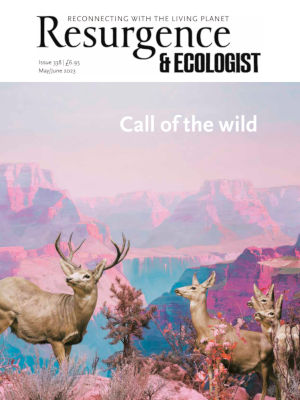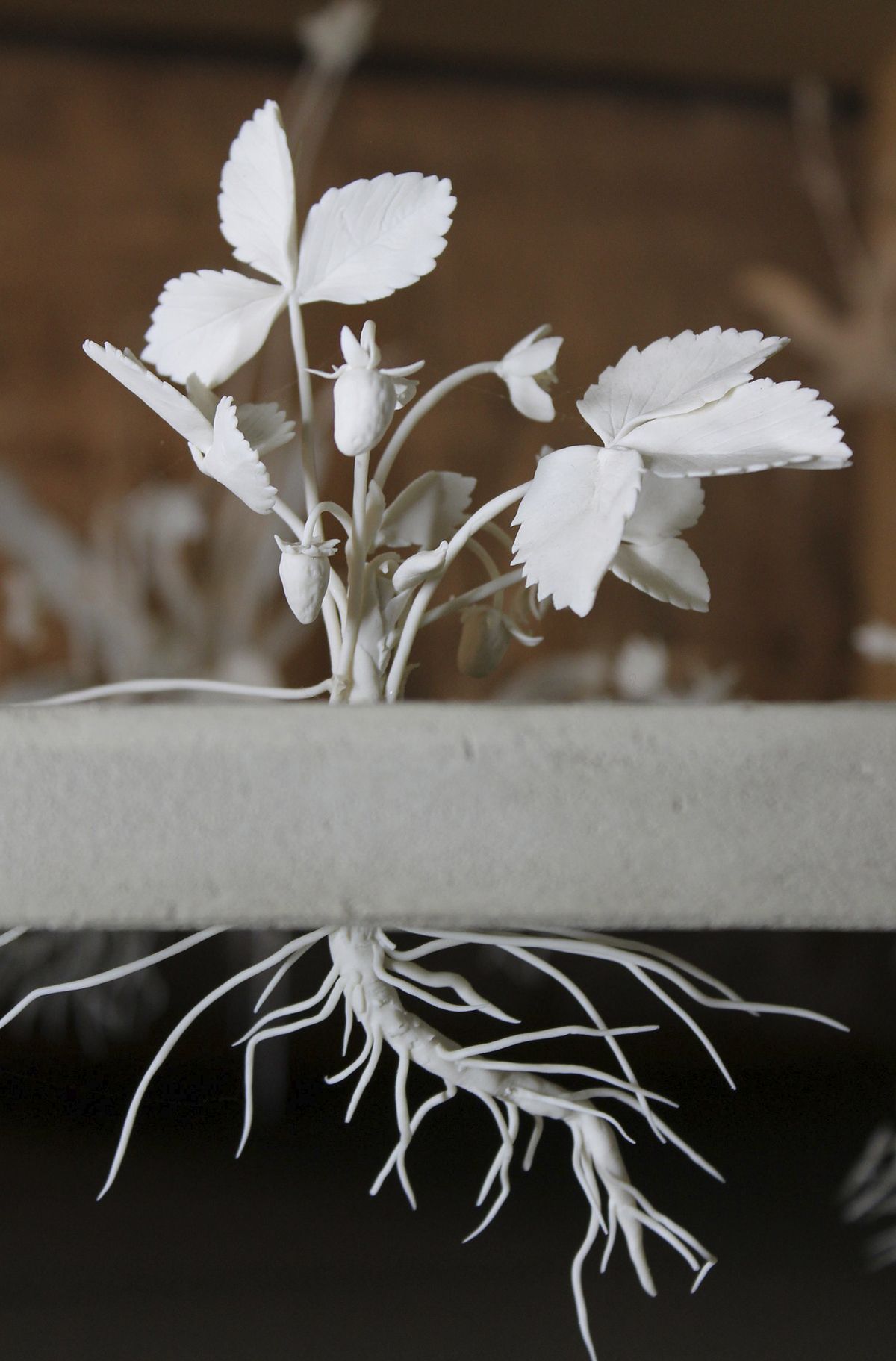Climb the stairs in London’s Garden Museum, and halfway up you discover a secret wild garden – a landscape of plants formed in pure white porcelain. Clover and cleavers. Bindweed and brambles. Poppies, nettles, violets and dog roses. Bluebells, buttercups, dandelions and daisies. Rendered in clay, these common and familiar plants that we so often overlook take on new wonder.
Lambeth Wilds, a large-scale, site-specific installation by ceramic artist Katie Spragg, is, in her words, a “landscape of the imagination”, a portrait of a place and people through plants.
The museum is housed in an old church in central London on the banks of the Thames. Once a rural hamlet, Lambeth is now one of the most built-up pieces of land on the planet. In the changing light of the church’s nave, the delicate, hand-modelled plants pushing up through cracks in a concrete slab draw attention to the wildness that exists even in this most urban of places.
For Spragg, making is a tool for connecting with people, opening up stories through working in clay. She created Lambeth Wilds in response to workshops she led with local residents, members of Clay for Dementia, and Lambeth Young Carers. The result is a celebration of individuals growing in community, and of the resilience of plants and of people in the face of all that might grind us down. It is an evocation of the innate wildness that we share, what poet Dylan Thomas called “the force that through the green fuse drives the flower”.
Clay is the perfect medium for a practice that celebrates human agency against the odds – at first malleable and mouldable, and then, once fired, transformed and strong. “Clay is so easily transformed. Being able to share that with people who might not feel like they’re able to change anything feels important. Speaking with them afterwards, that idea of transformation, how something changes in the kiln, that felt really special,” Spragg says.
Accompanying the installation, a book documents personal memories and stories about plants by people who contributed to the project. Botanical illustrations and photographs of pressed flowers from the museum’s archive are set alongside sketches by young carers of plants growing locally, the drawings linking generations of Lambeth residents living centuries apart. Poems on what it means to be a carer are accompanied by images of plants imprinted into clay tiles, and stills from stop-frame clay animations created by the young people.
“I was at first surprised and then delighted to see how much the young carers responded to the idea of using wild plants as a metaphor,” Spragg says. “I thought maybe this is just something I’m interested in, but they completely took it on board and related it to their lives. People connect with wild plants as symbols of resilience and hope.”
There is no sentimentality here. The poems and films speak of the toughness, strength and spirit it takes to care, the dignity and deep roots. These are qualities from which we can all learn.
“I see the participants in my workshops as experts,” the artist reflects. “We share expertise, my skills in making and their lived experience of caring. I want to show through the artwork that these are people who are experts in care and that, if we’re going to think about caring for the natural world, these are people who really know what it means to care.”
Spragg was already well known for her botanical sculptures, but in Lambeth Wilds for the first time the plants’ roots are also visible. What is hidden underground is as important as what is seen above the surface. She found inspiration delving into the museum’s archive of illustrations, especially those by 18th-century botanist and Lambeth local James Sowerby.
“I became excited by the roots of the plants. Normally hidden from view, in these drawings they were given as much prominence as the plant above ground. That gave me a metaphor for the communities celebrated in the piece – intertwined, connected, rooted.”
The piece is a reminder of the need for rootedness in our wildness, the value of putting down roots, investing in a place and community, making the choice to tend and attend, to be being in a place over time.
Spragg’s interest in working with plants sprang from a desire to make work about landscape through clay. A visit to the Brecon Beacons changed everything. “I became fascinated by a landscape shaped by humans, dotted with cairns and streaked with desire lines. I was struck by how the grasses were like clay – they pick up traces of people being there. The grass might be flattened or worn away, just as clay is receptive to human touch and bears its imprint.” Increasingly, she says, her eye was drawn into creating pieces about micro-landscapes.
As her practice has evolved, this zooming in has continued. Over the course of recent projects, Spragg’s work has become more delicate, and more and more focused on fine details. “That surprised me about myself,” she admits. Yet it is in keeping with reclaiming wild Nature. Paradoxically, as skills become more finely honed, our essential nature is set free, our wildness unleashed. And it is this fine focus, narrowing in onto the micro-landscapes of a specific place – be it Lambeth, the Cairngorms or, most recently, Iceland’s tundra – that enables Spragg to tell a bigger story of care for the natural environment as a whole.
It is also a story of our own wild nature. “Wildness is about our own individual lived experience,” she says. “When you don’t play by the rules. Going against the hegemony, acting in your own way, taking up space and making space. That’s why a plant growing up through a crack in a pavement is so exciting to me. And also running a workshop, making space to sit and chat and play with clay. To me, those two things are about the same thing – making space to do what you want to do, to be who you are.”
How does this fit with making work for the Garden Museum? The irony of creating a homage to wildness in an institution devoted to cultivation is not lost on her. “I planned the composition so that the plants appear to be sprouting from the fabric of the building – a wild area in a museum of cultivation. I’m often asked to do projects relating to gardens, but I’ve always sought out areas where plants are going against the rules of the gardener.”
This year sees Spragg embark on her most ambitious project yet, making work in response to three very different natural landscapes: the island of Menorca, the hills and gardens of Somerset, and a return full circle to the Cairngorms, where she first began her enquiry into wildness during a residency at Scottish Sculpture Workshop. She is especially excited about Menorca. “It’s a kind of landscape and botany that I haven’t made work about before. I’m intrigued to how see how it relates to these very British landscapes that I’ve been exploring.” Again, in this three-site project, the artist will be talking and working with local people across generations, sharing expertise and making together. The results will be seen at Make Hauser & Wirth Somerset this coming winter.
Spragg’s portrait of seemingly delicate plants pushing their way into the light through cracks in an unforgiving concrete is a reminder of the enduring animacy of the world in the face of hardness. It shows how tenderness can break through the resistance of, in the words of that other Lambeth resident and champion of wild human spirit, poet William Blake, the “mind forg’d manacles” that enshackle us.
Thoughtful and tender, Lambeth Wilds invites us to appreciate what is overlooked, to remember to care for the environment and our own wild natures. Barely visible from ground level or from the top of the museum stairs, Lambeth Wilds sits in an in-between space. It celebrates the wildness that is always there in the interstices of our lives, revealing itself to those who stop to look, those who care.
Katie Spragg will be talking about her work at the Resurgence Readers’ group meeting on 16 May, 7-8pm, followed by a Q&A. Free event, via zoom. For more information and tickets: www.resurgenceevents.org







